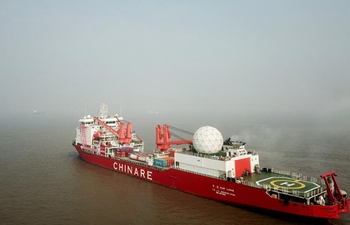SYDNEY, Nov. 9 (Xinhua) -- Australian researchers have discovered a new type of cell in the eye of a deep-sea fish, offering a new understanding of vision in low-light conditions.
The team from the University of Queensland found the new type of cell in pearlside fish, a tropical species usually found deep in the Pacific and Atlantic Oceans.
Pearlsides are different from most deep-sea fish in that they are mostly active at dusk and dawn compared to most fish living at depths greater than 200 meters which are active in the dark.
Fanny de Busserolles, a researcher from the Queensland Brain Institute at the University of Queensland, said that the retina of most vertebrates are made up of rods for vision in dim light and cones for daytime vision.
"Previously it was thought that pearlsides had retinas composed entirely of rods, but our new study has found this isn't the case," Busserolles said in a media release on Thursday.
"Humans use their cones during the day and rods at night, but during twilight, although not ideal, we use a combination of both.
"Pearlsides, being active mainly during twilight, have developed a completely different solution.
"Instead of using a combination of rods and cones, they combine aspects of both cells into a single and more efficient photoreceptor type."
The research discovered that the cells, which they named "rod-like cones," were perfectly suited for the unique light conditions the fish experience.
"(The study) improves understanding of how different animals see the world and how vision might have helped them to conquer even the most extreme environments, including the deep sea," lead researcher Justin Marshall said.














